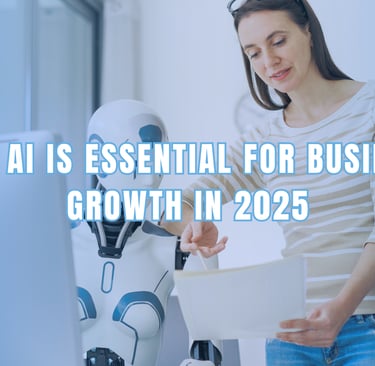
Why AI Is Essential for Business Growth in 2025
By AZ Konnect Team
10/29/20253 min read


Welcome to the Age of AI Adapt or Be Left Behind
Remember when businesses could ignore smartphones or skip social media and still thrive? Yeah... not anymore. Just like those tech revolutions, AI is here, and it’s completely rewriting the rules of business.
From predictive sales tools to AI-powered customer support, the businesses that are adapting fast are winning big. Meanwhile, those dragging their feet? They're missing opportunities, wasting time, and falling behind.
So, let’s talk about why AI adoption isn't just smart it's survival.
Why AI Adoption Has Shifted from Optional to Essential
1. Consumer Expectations Are Changing Fast
Today’s customers don’t just want speed. they expect it.
Think 24/7 support, instant answers, and lightning-fast order fulfillment. AI makes all of this possible:
Chatbots that handle common questions instantly
AI-driven CRMs that remember customer preferences
Personalized email automation based on behavior
If your business can’t match that speed and personalization? Well, your competitors can and will.
2. AI Unlocks a Massive Competitive Advantage
Using AI isn’t about replacing humans. it’s about supercharging your team. With the right tools, AI can:
Analyze customer data in real time
Recommend upsells during a sales call
Predict buying behavior before the customer even reaches out
This kind of insight is like having a cheat code for smarter decisions.
3. Manual Processes Are Costing You Money
Still stuck in spreadsheets and manual workflows? That’s not just time-consuming. it’s expensive.
AI automates repetitive tasks like:
Scheduling meetings
Sorting emails
Managing inventory
Handling HR onboarding
When your team stops spending time on low-value tasks, they can focus on the high-impact stuff that actually moves the needle.
4. Data-Driven Decisions Are No Longer Optional
Gut feelings are great. for poker games, not business decisions. AI helps eliminate guesswork by giving you real-time, accurate data that helps you:
Forecast sales trends
Monitor customer satisfaction
Improve product development cycles
Businesses that use AI to track KPIs and tweak strategy based on data are way ahead of the curve.
5. AI Tools Are More Accessible Than Ever
Five years ago, AI tools were expensive and confusing. Today? Not so much.
You’ve got plug-and-play platforms for:
Sales: Salesforce Einstein, Gong, Pipedrive AI
Marketing: HubSpot AI, Jasper, Copy.ai
Customer Support: Intercom, Freshdesk, Zendesk AI
Operations: Zapier, Notion AI, monday.com AI
No massive budget or data scientist required. Just a little willingness to adapt.
How Businesses Are Actually Using AI (Real Examples)
Let’s move beyond theory. Here’s how real companies are using AI every single day:
Sales
Example: A SaaS startup used AI call analysis to identify high-converting sales scripts resulting in a 30% boost in close rate.
Customer Support
Example: An eCommerce store implemented an AI chatbot that reduced human support tickets by 45% in the first 60 days.
Marketing
Example: A digital agency uses AI to test headlines, optimize ad copy, and personalize emails saving hours per week.
Product Development
Example: A fitness app leverages user data + AI to recommend custom workout plans, increasing retention by 20%.
“But I Already Use ChatGPT, Isn’t That Enough?”
Not quite.
While ChatGPT is a powerful AI assistant (and yes, we’re fans), it's just one tool in a massive toolbox.
What ChatGPT can do:
Draft content
Answer questions
Brainstorm ideas
Write code
What it can’t do (on its own):
Automate workflows across your business
Integrate with CRMs or project tools
Provide predictive analytics
Track and optimize customer journeys
Using ChatGPT is a great first step. But to truly level up, you need to build a full AI ecosystem tailored to your business operations.
What Happens If You Don’t Adapt?
Let’s be blunt AI isn’t a trend, it’s a full-blown shift. Businesses that fail to adapt will face:
Slower growth
Higher costs
Lower customer retention
More human error
Competitive obsolescence
In short? You risk becoming the Blockbuster in a Netflix world.
Getting Started: How to Begin AI Integration Today
Not sure where to start? Here’s a beginner-friendly roadmap:
Step 1: Identify Repetitive Tasks
Look at your team’s daily routine. Anything that’s done over and over again is a candidate for automation.
Step 2: Pick One Area to Optimize
Sales, support, operations. start with one area and scale up.
Step 3: Choose Beginner-Friendly Tools
Try tools like:
Zapier for workflow automation
HubSpot AI for marketing
Tidio for customer support
Grammarly or Jasper for content creation
Step 4: Train Your Team
Change is only effective if your team is on board. Invest in AI literacy and hands-on demos.
FAQs
Q: Is AI only for tech companies?
Nope! From retail to healthcare, restaurants to consultants. AI can be applied anywhere workflows, customer service, or marketing exist.
Q: Will AI replace jobs?
It’ll shift them. AI takes over repetitive work, freeing up humans for creative, strategic, and interpersonal roles.
Q: Isn’t AI expensive?
Many AI tools are free or low-cost for small businesses. The ROI often pays for itself quickly through time saved.
Q: How can I trust AI with my data?
Use reputable tools with strong privacy policies and encrypted security standards.
🚀 Ready to Adapt? Let’s Recap
So, what’ve we learned?
AI isn’t coming. it’s already here
It’s no longer a luxury; it’s essential
Businesses using AI are gaining a serious edge
Tools are affordable and accessible, even for small teams
ChatGPT is great, but it’s just the tip of the iceberg
The businesses that thrive tomorrow are the ones adopting AI today.
Further Reading & Resources:
OpenAI’s business AI roadmap
Gartner’s AI Trends for 2025
AI Adoption Report by McKinsey
Subscribe To Our Newsletter


